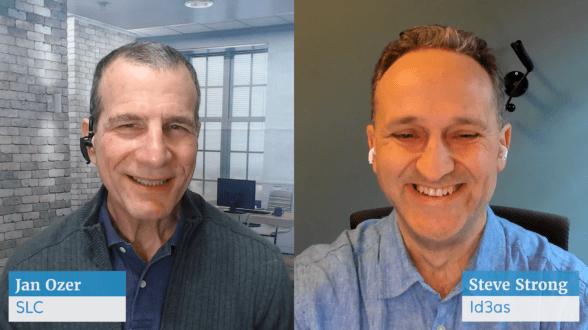Recently, I spoke with Steve Strong, id3as’ co-founder and director, about Norsk’s suitability for broadcasters. Below is the video and a summary of the conversation.
Contents
Overview
By way of background, many traditional broadcasters are transitioning from legacy platforms to IP-based systems. A key player facilitating this shift is id3as with their new product, Norsk.
Briefly, Norsk is a suite of tools for creating and managing live media workflows. It integrates production capabilities, such as multi-camera inputs and overlays, with transcoding and packaging, all within a single server framework. This integration significantly reduces latency and minimizes capital and operational expenses, offering unparalleled system density.
Video 1. The complete interview.
Regarding the individual tools, Norsk Manager manages customers’ on-prem, cloud, or hybrid infrastructure, while Norsk Media handles production, including multi-camera inputs, overlays, and similar elements, and transcoding and packaging, all on a single server for minimal latency and CAPEX/OPEX and maximum density. Norsk Media provides a low-code, high-level scripting language and soon (launching at NAB 2024) a no-code drag-and-drop development interface called Norsk Studio for accelerated prototyping and workflow creation.
Norsk automatically handles most low-level media-related workflows like transcoding, transmuxing, and packaging, so developers can focus on business and UI elements that provide real differentiation and improved QoE.
Drawing on 14 years of experience in high-volume, high-availability live streaming, Norsk’s workflows are exceptionally resilient, ensuring reliability under the most demanding conditions. This resilience, coupled with Norsk’s streamlined workflow management, positions it as an essential tool for broadcasters and content providers looking to maximize efficiency and adaptability in their live streaming operations.
The Shift to IP Broadcasting
During the interview, Strong noted that one primary audience for Norsk is tier-one broadcasters aiming to monetize premium content through live streams. Norsk shines in the progression from broadband to IP broadcasting, offering a seamless transition for broadcasters moving to Internet protocol-based delivery systems.
Excerpt 1: Steve demos adding Whisper-based transcription to a workflow.
Today, many broadcasters use appliance-based systems for production and transcoding, which means separate systems connecting over a network. This involves significant CAPEX and OPEX and often limited functionality and inflexibility. As Strong notes, “You’re limited to the functionality those boxes offer. Sometimes that’s not a problem; sometimes it is.”
Latency and scalability also emerge as critical pain points in traditional setups. The latency, often in the order of seconds, results from the cumulative delays of each appliance in the chain. Scaling up in such an environment necessitates additional hardware, further complicating and limiting the broadcasters’ capabilities. It can also be challenging to scale to the cloud; even if one system may offer a cloud alternative, broadcasters must find an alternative for each appliance in the chain.
Norsk: Ideal for Broadcasters
Norsk is a feature-rich platform designed to alleviate these challenges. It offers multiple broadcast-level features, including SCTE-35 management for ad insertion, DRM, KLV metadata processing, HDR metadata support, and closed captioning capabilities. This breadth of functionality provides broadcasters with the tools needed for comprehensive content management and monetization.
Excerpt 2: Steve demos Norsk’s SCTE-35 integration.
During the discussion, Steve demonstrated the flexibility and ease of use inherent in Norsk’s design. Through a live demo, he showcased the SCTE-35 feature set and the platform’s integration with advanced transcription services such as AWS, Azure, and Whisper from OpenAI. As Whisper is currently free with Norsk, it’s a money-saving alternative to for-fee services like AWS and Azure. This integration also highlights Norsk’s adaptability and its ability to leverage the latest technological advancements to enhance broadcast workflows.
The Advantages of Adopting Norsk
Choosing Norsk for broadcast applications presents numerous benefits, chief among them being flexibility. The platform’s low-code SDK and no-code Studio enable broadcasters to rapidly adapt and modify their workflows to meet evolving requirements without being constrained by hardware limitations. This flexibility extends to scalability, with Norsk capable of running both on-premises and in the cloud, allowing for efficient management of variable workloads.
Excerpt 3: Norsk compared to off-the-shelf appliances for broadcasters.
By consolidating production, transcoding, and packaging into a single, efficient platform, Norsk also reduces streaming latency. This lowers capital and operational expenses and frees up valuable rack space, making IT teams’ lives easier.
Transitioning to Norsk
For broadcasters currently entrenched in appliance-based systems, Steve recommends a gradual transition to Norsk. This approach allows broadcasters to maintain existing workflows while experimenting with Norsk’s capabilities, ensuring a smooth and risk-free migration.
Conclusion
Via its comprehensive suite of tools for live media workflows, Norsk streamlines production, transcoding, and packaging into a single server, reducing latency and operational expenses while maximizing system density. With a comprehensive and easy-to-access feature set, Norsk presents broadcasters with a cost-effective and efficient solution for modern broadcasting challenges. id3as invites visitors to explore Norsk further at NAB 2024, with additional information available at https://norsk.video/.
 Streaming Learning Center Where Streaming Professionals Learn to Excel
Streaming Learning Center Where Streaming Professionals Learn to Excel









